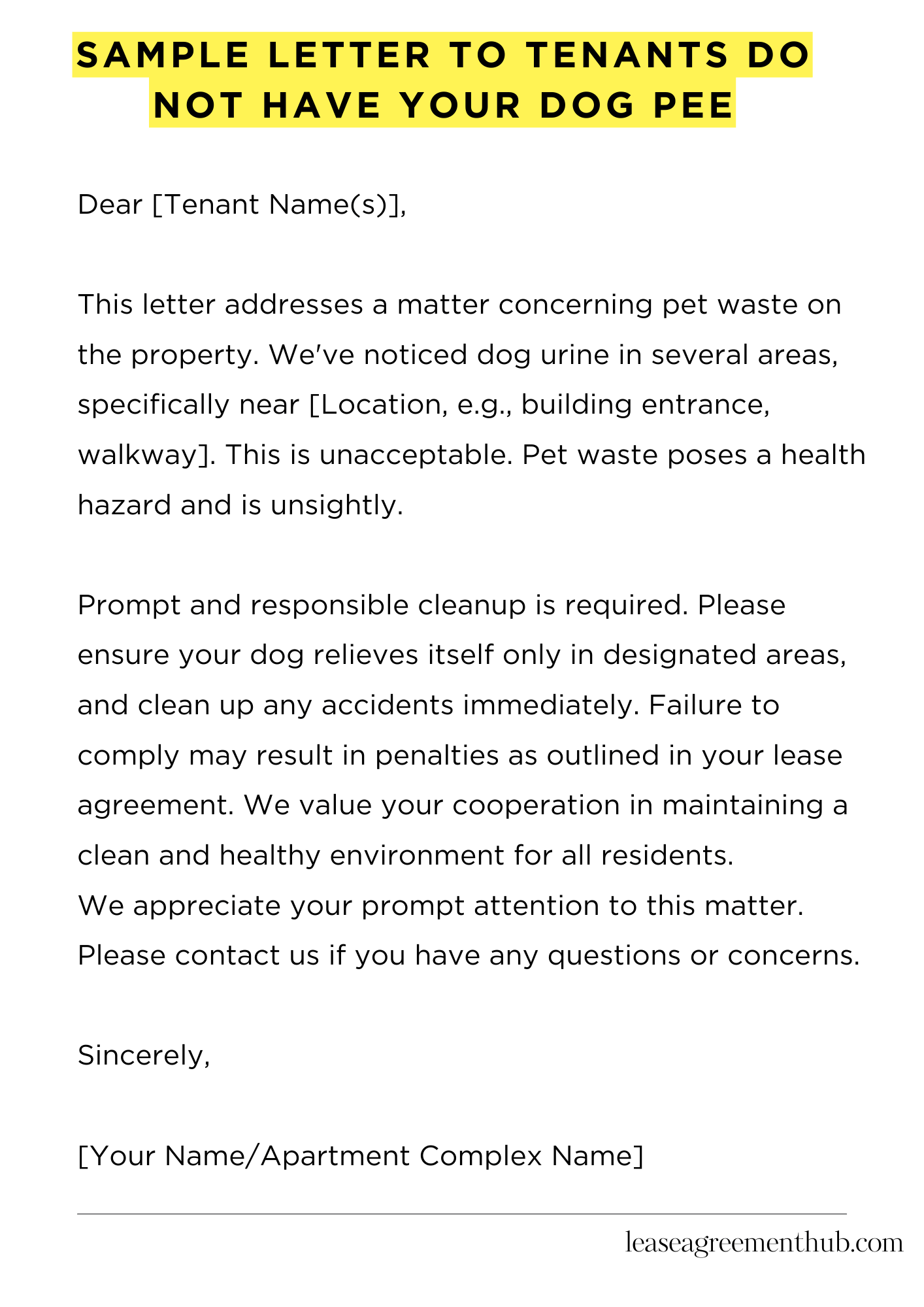Dealing with dog urine on your property is frustrating. This article helps landlords and property managers. It provides sample letters.
We’ll give you ready-made letter templates. These are examples. You can adapt them to your situation. Save time and effort.
Use these samples as a starting point. Customize them for your needs. Communicate clearly and effectively. Solve the problem quickly.
sample letter to tenants do not have your dog pee
[Your Name/Apartment Complex Name]
[Your Address]
[Your Phone Number]
[Your Email]
[Date]
[Tenant Name(s)]
[Tenant Apartment Number]
[Apartment Complex Address]
Dear [Tenant Name(s)],
This letter addresses a matter concerning pet waste on the property. We’ve noticed dog urine in several areas, specifically near [Location, e.g., building entrance, walkway]. This is unacceptable. Pet waste poses a health hazard and is unsightly.
Prompt and responsible cleanup is required. Please ensure your dog relieves itself only in designated areas, and clean up any accidents immediately. Failure to comply may result in penalties as outlined in your lease agreement. We value your cooperation in maintaining a clean and healthy environment for all residents.
We appreciate your prompt attention to this matter. Please contact us if you have any questions or concerns.
Sincerely,
[Your Name/Apartment Complex Name]

How to Write a Sample Letter to Tenants to Address Dog Urine Issues
Understanding the Nuances of the Situation
Before composing your missive, carefully consider the context. Is this a first offense? Has the tenant been previously warned? Knowing the history informs your tone and approach. A first-time infraction warrants a gentler, more conciliatory approach than a repeated offense. Clarity is paramount; ambiguity breeds resentment.
Crafting a Salutation: Setting the Tone
Your opening sets the stage for the entire communication. Avoid overly familiar salutations; maintain a professional demeanor. A simple “Dear [Tenant Name]” suffices. Eschew overly casual language. This isn’t a friendly chat; it’s a formal notification. Remember, your goal is to resolve the issue amicably, not to exacerbate it.
Articulating the Problem: Direct and Unambiguous Language
State the issue plainly, citing specific instances if possible. Vague statements are unhelpful. For example, instead of writing “There have been some issues,” be specific: “On [Date], canine urination was observed on [Location].” Use precise language to leave no room for misinterpretation. This demonstrates seriousness without being unnecessarily aggressive. Objectivity is key.
Outlining the Consequences: Establishing Expectations
Clearly articulate the consequences of continued non-compliance. This might include further warnings, financial penalties, or even lease termination. This is not a threat, but a statement of fact. Be certain the consequences are clearly spelled out in your lease agreement. Transparency protects both parties from future disputes. Avoid hyperbole; stick to the specifics of your lease and local ordinances.
Offering Solutions: Collaborative Problem-Solving
Propose solutions where possible. Suggest dog-walking services, pet waste disposal solutions, or even offer to mediate a discussion. A collaborative approach often yields better results than a purely punitive one. This demonstrates your willingness to work with the tenant, fostering a positive, proactive relationship. Don’t underestimate the value of amicable resolution.
Concluding with a Call to Action: A Clear Next Step
End with a clear call to action. Request a response by a specific date outlining how the tenant plans to remediate the issue. This provides a deadline for action and allows for follow-up communication if necessary. A concise summary of expectations ensures everyone is on the same page. Establish a structured, timely response mechanism.
Review and Revision: Ensuring Clarity and Professionalism
Before sending, carefully proofread your letter. Check for grammatical errors, typos, and any inconsistencies. A well-written, professional letter demonstrates respect for the tenant while maintaining a firm stance on the issue. A polished letter reflects well on you and your property management practices. This final step is crucial to effectiveness.
FAQs about sample letter to tenants do not have your dog pee
Dealing with pet waste issues in a rental property requires clear communication. A well-written letter can effectively address the problem and prevent further occurrences.
How should I start the letter to ensure a professional tone?
Begin with a polite yet firm salutation, addressing the tenant(s) by name. Avoid accusatory language and instead focus on the issue at hand. For example, you could start with: “Dear [Tenant Name(s)], This letter addresses a matter concerning pet waste on the property.”
What specific details should I include about the dog’s urination?
Clearly state where the dog urination is occurring (e.g., specific location on the lawn, near the building). Mention the frequency of the issue and any resulting damage or inconvenience. Avoid overly emotional language and stick to factual observations. For example: “We have noticed repeated instances of dog urine on the lawn near the building’s entrance.”
What are the consequences of not addressing the issue?
Clearly state the consequences of continued dog urination. This might include penalties as outlined in the lease agreement (e.g., fines, lease termination). Phrasing should be firm but fair. For instance: “As per the terms of your lease agreement, failure to rectify this issue may result in penalties.”
How can I politely request a solution from the tenant?
Offer the tenant an opportunity to resolve the issue. Suggest potential solutions like using designated areas for pet relief, frequent cleanup, or training the dog. Frame this as a collaborative effort to maintain a clean and pleasant environment for everyone. For example: “We would appreciate it if you could implement measures to prevent further incidents of dog urination on the property.”
How should I conclude the letter and what is the next step?
End the letter with a polite closing and a clear timeframe for the tenant to respond or take action. Include contact information for follow-up. For example: “We request a response within [Number] days outlining the steps you will take to address this matter. Please contact us at [Phone Number] or [Email Address]. Sincerely, [Your Name/Property Management Company].”
Related: